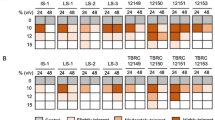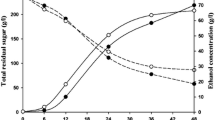Abstract
Nine indigenous cachaça Saccharomyces cerevisiae strains and one wine strain were compared for their trehalose metabolism characteristics under non-lethal (40°C) and lethal (52°C) heat shock, ethanol shock and combined heat and ethanol stresses. The yeast protection mechanism was studied through trehalose concentration, neutral trehalase activity and expression of heat shock proteins Hsp70 and Hsp104. All isolates were able to accumulate trehalose and activate neutral trehalase under stress conditions. No correlation was found between trehalose levels and neutral trehalase activity under heat or ethanol shock. However, when these stresses were combined, a positive relationship was found. After pre-treatment at 40°C for 60 min, and heat shock at 52°C for 8 min, eight strains maintained their trehalose levels and nine strains improved their resistance against lethal heat shock. Among the investigated stresses, heat treatment induced the highest level of trehalose and combined heat and ethanol stresses activated the neutral trehalase most effectively. Hsp70 and Hsp104 were expressed by all strains at 40°C and all of them survived this temperature although a decrease in cell viability was observed at 52°C. The stress imposed by more than 5% ethanol (v/v) represented the best condition to differentiate strains based on trehalose levels and neutral trehalase activity. The investigated S. cerevisiae strains exhibited different characteristics of trehalose metabolism, which could be an important tool to select strains for the cachaça fermentation process.




Similar content being viewed by others
References
Alexandre H, Plourde L, Charpentier C, François J (1998) Lack of correlation between trehalose accumulation, cell viability and intracellular acidification as induced by various stresses in Saccharomyces cerevisiae. Microbiology 144:1103–1111
Crowe JH, Crowe LM, Oliver AE, Tsvetkova N, Wolkers W, Tablin F (2001) The trehalose myth revisited: introduction to a symposium on stabilization of cells in the dry state. Cryobiology 43:89–105
Elbein AD, Pan YT, Pastuszak I, Carroll D (2003) New insights on trehalose: a multifunctional molecule. Glycobiology 13:17–27
Foschino R, Gallina S, Andrighetto C, Rossetti L, Galli A (2004) Comparison of cultural methods for the identification and molecular investigation of yeasts from sourdoughs for Italian sweet baked products. FEMS Yeast Res 4:609–618
Gasch AP, Spellman PT, Kao CM, Carmel-Harel O, Eisen MB, Storz G, Botstein D, Brown PO (2000) Genomic expression programs in the response of yeast cells to environmental changes. Mol Biol Cell 11:4241–4257
Gomes FCO, Pataro C, Guerra JB, Neves MJ, Côrrea SR, Moreira ESA, Rosa CA (2002) Physiological diversity and trehalose accumulation in Schizosaccharomyces pombe strains isolated from spontaneus fermentation during the production of Brazilian cachaça. Can J Microbiol 48:399–406
Guerra JB, Araújo RAC, Pataro C, Franco GR, Moreira ESA, Mendonça-Hagler LC, Rosa CA (2001) Genetic diversity of Saccharomyces cerevisiae strains during the 24 h fermentative cycle for the production of the artisanal Brazilian cachaça. Lett Appl Microbiol 33:106–111
http://www.lalvinyeast.com/strains.asp. Cited 17 Jan 2007
Ivorra C, Pérez-Ortín JE, del Olmo M (1999) An inverse correlation between stress resistance and stuck in fermentations in wine yeasts. A molecular study. Biotech Bioeng 64:698–708
Kurtzman CP, Fell JW (1998) The yeasts: a taxonomic study, 4th edn. Elsevier Science, Amsterdam
Lewis JG, Learmonth RP, Watson K (1995) Induction of heat, freezing and salt tolerance by heat and salt shock in Saccharomyces cerevisiae. Microbiology 141:687–694
Lindquist S, Kim G (1996) Heat-shock protein 104 expression is sufficient for thermotolerance in yeast. Microbiology 93:5301–5306
Martini S, Ricci M, Bartolini F, Bonechi C, Braconi D, Millucci L, Santucci A, Rossi C (2006) Metabolic response to exogenous ethanol in yeast: an in vivo NMR and mathematical modeling approach. Biophys Chem 120:135–142
Mills DR (1941) Differential staining of living and dead yeast cells. Food Res 6:361–371
Morais PB, Rosa CA, Linardi VR, Pataro C, Maia ABRA (1997) Characterization and succession of yeast associated with spontaneous fermentation during the production of Brazilian sugar cane aguardente. World J Microbiol Biotech 13:241–243
Neves MJ, Terenzi HF, Leone FA, Jorge JA (1994) Quantification of trehalose in biological samples with conidial trehalase from thermophilic fungus Humicola grisea var. thermoidea. World J Microbiol Biotech 10:17–19
Nwaka S, Kopp M, Burgert M, Deuchler I, Kienle I, Holzer H (1994) Is thermotolerance of yeast dependent on trehalose accumulation? FEBS Lett 344:225–228
Nwaka S, Kopp M, Holzer H (1995) Expression and function of the trehalase genes NTH1 and YBR0106 in Saccharomyces cerevisiae. J Biol Chem 270:10193–10198
Nwaka S, Mechler B, von Ahsen O, Holzer H (1996) The heat shock factor and mitochondrial Hsp70 are necessary for survival of heat shock in Saccharomyces cerevisiae. FEBS Lett 16:259–263
Parrou JL, Teste MA, Francois J (1997) Effects of various types of stress on the metabolism of reserve carbohydrates in Saccharomyces cerevisiae: genetic evidence for a stress-induced recycling of glycogen and trehalose. Microbiology 143:1891–1900
Pataro C, Guerra JB, Petrillo-Peixoto ML, Mendonça-Hagler LC, Linardi VR, Rosa CA (2000) Yeast communities and genetic polymorphism of Saccharomyces cerevisiae strains associated with artisanal fermentation in Brazil. J Appl Microbiol 89:24–31
Pataro C, Guerra JB, Gomes FCO, Neves MJ, Pimentel PF, Rosa CA (2002) Trehalose accumulation, invertase activity and physiological characteristics of yeasts isolated from 24 h fermentative cycles during the production of artisanal Brazilian cachaça. Braz J Microbiol 33:202–208
Pérez-Torrado R, Bruno-Barcena JM, Matallana E (2005) Monitoring stress-related genes during the process of biomass propagation of Saccharomyces cerevisiae strains used for wine making. Appl Environ Microbiol 71:6831–6837
Piper PW (1995) The heat shock and ethanol stress responses of yeast exhibit extensive similarity and functional overlap. FEMS Microbiol Lett 15:121–127
Querol A, Barrio E, Ramón D (1992) A comparative study of different methods of yeast strain characterization. Syst Appl Microbiol 15:439–446
Sales K, Brandt W, Rumbak E, Lindsey G (2000) The LIA-like protein HSP12 in Saccharomyces cerevisiae has plasma membrane location and protects membranes against desiccation and ethanol induced stress. Biochim Biophys Acta 1463:267–278
Sharma SC (1997) A possible role of trehalose in osmotolerance and ethanol tolerance in Saccharomyces cerevisiae. FEMS Microbiol Lett 152:11–15
Sharma SC, Anand MS (2006) Role of selenium supplementation and heat stress on trehalose and glutathione content in Saccharomyces cerevisiae. Appl Biochem Biotech 133:1–7
Singer MA, Lindquist S (1998) Thermotolerance in Saccharomyces cerevisiae: the Yin and Yang of trehalose. Trends Biotechnol 16:460–468
Tanghe A, Prior B, Thevelein JM (2006) Yeast responses to stresses. In: Rosa CA, Péter G (eds) Biodiversity and ecophysiology of yeasts, 1st edn. Springer-Verlag, Berlin, Heidelberg
Trabalzini L, Paffetti A, Scaloni A, Talamo F, Ferro E, Coratza G, Bovalini L, Lusini P, Martelli P, Santucci A (2003) Proteomic response to physiological fermentation stresses in a wild-type wine strain of Saccharomyces cerevisiae. Biochem J 370:35–46
Wera S, De Schrijver E, Geyskens I, Nwaka S, Thevelein JM (1999) Opposite roles of trehalase activity in heat-shock recovery and heat-shock survival in Saccharomyces cerevisiae. Biochem J 343: 621–626
Wiemken A (1990) Trehalose in yeast, stress protectant rather than reserve carbohydrate. Antonie van Leeuwenhoek 58:209–217
Yarrow D (1998) Methods for isolation, maintenance, classification and identification of yeasts. In: Kurtzman CP, Fell JW (eds) The Yeasts: a taxonomic study, 4th edn. Elsevier Science, Amsterdam
Zähringer H, Burgert M, Holzer H, Nwaka S (1997) Neutral trehalase Nth1p of Saccharomyces cerevisiae encoded by the NTH1 gene is a multiple stress responsive protein. FEBS Lett 412:615–620
Zähringer H, Thevelein JM, Nwaka S (2000) Induction of neutral trehalase Nth1 by heat and osmotic stress is controlled by STRE elements and Msn2/Msn4 transcription factors: variations of PKA effect during stress and growth. Mol Microbiol 35:397–406
Zuzuarregui A, Carrasco P, Palacios A, Julien A, del Olmo M (2005) Analysis of the expression of some stress induced genes in several commercial wine yeast strains at the beginning of vinification. J Appl Microbiol 98:299–307
Acknowledgements
This work was supported by the Centro de Desenvolvimento da Tecnologia Nuclear (CDTN), Conselho Nacional de Desenvolvimento Científico e Tecnológico (CNPq) and Fundação de Amparo à Pesquisa do Estado de Minas Gerais (FAPEMIG). We thank the editor for her critical reading of the manuscript and helpful suggestions.
Author information
Authors and Affiliations
Corresponding author
Rights and permissions
About this article
Cite this article
Vianna, C.R., Silva, C.L.C., Neves, M.J. et al. Saccharomyces cerevisiae strains from traditional fermentations of Brazilian cachaça: trehalose metabolism, heat and ethanol resistance. Antonie van Leeuwenhoek 93, 205–217 (2008). https://doi.org/10.1007/s10482-007-9194-y
Received:
Accepted:
Published:
Issue Date:
DOI: https://doi.org/10.1007/s10482-007-9194-y




